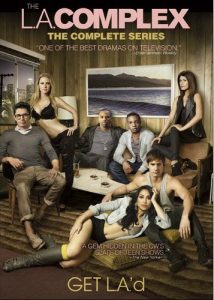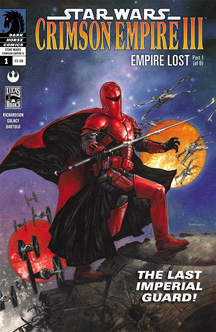A decade after the first two installments of “Crimson Empire” in both real time and on the “Star Wars” timeline, the six-issue “Crimson Empire III: Empire Lost” (2011-12) was finally released, and it was almost certainly different from the version that would have existed had it been released right after “Crimson Empire II.”
While one might assume the adjustments came because of new additions to the “Star Wars” timeline, it seems more like writers Randy Stradley and Mike Richardson simply changed their mind about the motivations of their main character, the former Emperor’s Royal Guard Kir Kanos.
According to Wookieepedia’s entry on “Crimson Empire,” the saga’s concept came from a Stradley pitch for the original Marvel “Star Wars” comic series that was rejected by Lucasfilm: After “Return of the Jedi,” a handful of Royal Guards would seek vengeance on Luke.
In the late 1990s, Lucasfilm became open to the idea of exploring the crimson guards, so Stradley and Richardson then imagined a single guard, Kanos, seeking vengeance on three entities over the course of a trilogy: First, Carnor Jax, who had destroyed the last of Palpatine’s clones; this was “Crimson Empire I.” Second, those who claimed Palpatine’s throne, the Council of Moffs; this was “Crimson Empire II: Council of Blood.” And third, Luke Skywalker, who Kanos believed murdered Palpatine on Death Star II; this was to be “Crimson Empire III.”
But as it turned out, “Crimson Empire III: Empire Lost” finds Kanos taking on Ennix Devian, a former hitman for Palpatine. Despite this intriguing backstory, don’t bother looking for him in other stories; he only appears in “Crimson Empire III.” Devian is essentially a new Carnor Jax: He claims to lead a Restored Empire, and Kanos wants to kill him for that.
According to Wookieepedia, new additions to the timeline in the 2000s inspired Stradley and Richardson to move away from the “Kanos versus Luke” pitch, but that doesn’t totally jibe. Kanos taking on Luke would’ve been a more fitting end to the “Crimson Empire” trilogy, as we would’ve seen Kanos increasingly biting off more than he could chew, possibly learning a lesson about how vengeance had blinded him. From an artistic standpoint (a hallmark of the whole “Crimson Empire” saga, with penciller Paul Gulacy and colorist Michael Bartolo handling this final chapter), we would’ve seen epic panels of Luke taking on a Royal Guard in combat.
The fact that Kanos works with the good guys gives a hint as to why Stradley abandoned his original idea: He decided that Kanos had changed his mind about vengeance on Luke (Kanos openly swears vengeance on Luke earlier in the saga). During his decade in the guise of bounty hunter Kenix Kil, Kanos seems to have gradually realized that Palpatine’s Empire wasn’t as wonderful as he thought and the New Republic – and Luke — isn’t so bad. These things are never explicitly stated in the narrative, as Kanos is not a talkative guy, nor do we get an internal monologue. So “Crimson Empire III’s” tension comes from the question of “What will Kanos do?”

That having been said, Stradley certainly does pay close attention to the timeline of the Bantam novels; “Crimson Empire III” slots in just after “Planet of Twilight.” He explores a failed attempt at a peace treaty between the Empire and the Republic prior to the actual peace achieved in Zahn’s “Hand of Thrawn” duology a few years later. There, it is Pellaeon and Leia who meet, but here it is lower-ranking representatives; the Republic is represented by Mirith Sinn and, ironically, Kanos. Things go haywire because of infighting among various Imperial groups, delaying the peace treaty until “Hand of Thrawn.”
As with the first two “Crimson Empire” installments, “Crimson Empire III” can be boiled down to a simple synopsis, but it’s loaded with character subtleties and plot machinations, so it has to be read carefully.
Leia – the chief of state at this point on the timeline — trusts her head of security, Mirith Sinn. Since Sinn, broadly speaking, trusts her former lover Kanos, Leia does too. Luke does not trust Kanos, or even Mirith Sinn. This is somewhat at odds with most portrayals of Leia and Luke. Leia, a political leader, usually has to be wary about trusting former Imperials. Luke, with his Force abilities, usually has a more accurate sense of a person’s intentions.
The most notable difference from the first two chapters is that “Crimson Empire III” heavily features the saga’s main characters. So even though we don’t get the “Luke versus Crimson Guard” visuals, we do get a fair amount of Luke. We see Leia in action in the Senate building, helping to fend off a kidnapping attempt (by one of those Imperial splinter groups) on her three children, who get their most prominent comics exposure outside of “Invasion,” which was published around the same time but features Jaina, Jacen and Anakin a decade later, when they are teenagers.
Han is a New Republic general during this time. Seeing him standing on a battleship bridge is a nice visual accompaniment to his novel portrayals in “The Courtship of Princess Leia” and the “X-wing” books, when he leads the task force pursuing Warlord Zsinj. Here, he is cleaning up the mess in the Nam Chorios sector in the wake of “Planet of Twilight.”
For the first time in the “Crimson Empire” saga, Stradley and Richardson acknowledge Grand Admiral Pellaeon being a major figure in Imperial circles; indeed, Pellaeon’s Imperial Remnant will end up emerging as the true Imperial government by the time of “Hand of Thrawn” and the “New Jedi Order.” The writers also give another nod to Nom Anor, the Yuuzhan Vong’s advance agent. In “Crimson Empire II,” he manipulates the Council of Moffs; this time, he stirs up unrest on Adumar (a subtle tie-in to the events of “Starfighters of Adumar”) with anti-New Republic speeches, a tactic he will later use on Rhammamool in “Vector Prime.” Boba Fett also makes a cameo, delivering Kanos to Devian.
For all Stradley’s and Richardson’s admirable attention to continuity, the “Crimson Empire” trilogy fizzles out. Not only does Kanos realize that he doesn’t want to kill Luke, but Mirith Sinn decides she is done with serving the New Republic. Her thoughts are held even closer to the vest than Kanos’, although broadly speaking, she seems depressed that her one-time lover Kanos is dead (he’s not, but she thinks he is). Sinn also perhaps is starting to question public service in a less frothy way than Nom Anor’s acolytes. Darth Vader killed her husband (as we see in a flashback panel), and Leia – the new government leader — is Darth Vader’s daughter, so Sinn may be wondering whether she’s serving good or evil.
Rather than an epic conclusion, “Crimson Empire III” feels more like a lead-in to the next chapter of the lives of Kanos and Sinn. But neither character appears later in the saga, nor are they even mentioned. It would’ve been cool to have them pop up in a later story, with the author digging into the specifics of how Kanos’ worldview changed and how Sinn’s feelings for Kanos and about governmental power in general guided her career choices.
Of course, the “New Jedi Order,” “Legacy of the Force” and most of “Fate of the Jedi” were already written when “Crimson Empire III” came out, which is why Kanos and Sinn don’t appear there. There’s no indication of any plans to continue their stories; it seems Stradley and Richardson were content to let them fade away into less public lives. Maybe Kanos continued to work as a bounty hunter; perhaps Sinn found a private security job. We’ll never know, as Disney unfortunately rebooted the “Star Wars” continuity in 2014.
In the end, the “Crimson Empire” saga stands as an artistic masterpiece accompanied by intriguing but underexplored characters and plots that are more confusing than they need to be. For fans of comic art, it’s a must-have; for fans of character journeys, it’s a truncated path.

